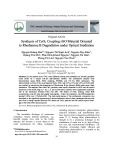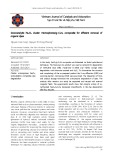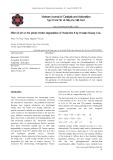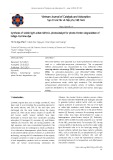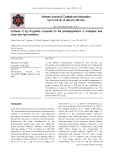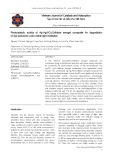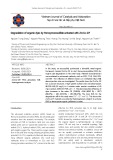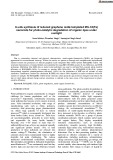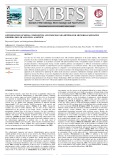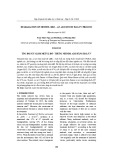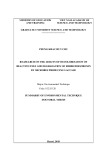
Dye degradation
-
In the present work, CeO2 with different loading was embedded on reduced graphene oxide (rGO) by a simple one-pot hydrothermal method. The synthesized samples were characterized using XRD, EDX mapping, FESEM, and UV-Vis DRS techniques.
 11p
11p  vifilm
vifilm
 11-10-2024
11-10-2024
 3
3
 1
1
 Download
Download
-
In this study, Fe3O4/g-C3N4 composite was fabricated via facile hydrothermal techniques. The Fe3O4/g-C3N4 product was used as catalysts for degradation of methylene blue (MB), rhodamine B (RhB) and methyl orange (MO) degradation with ultrasonic-assisted and H2O2.
 6p
6p  vikwong
vikwong
 29-09-2024
29-09-2024
 3
3
 1
1
 Download
Download
-
The pH solution is one of the critical factors affecting the photo-Fenton degradation of dyes in wastewater. This study has shown the role and potential of the application of photocatalysts in the degradation of toxic organic compounds the wastewater.
 5p
5p  vikwong
vikwong
 29-09-2024
29-09-2024
 3
3
 1
1
 Download
Download
-
The results showed that GdFeO3 photocatalyst had a good performance under visible light irradiation. The remarkable enhancement photo-Fenton catalytic activity of GdFeO3 material could be attributed to its small particle size and narrow band gap energy.
 6p
6p  vikwong
vikwong
 29-09-2024
29-09-2024
 2
2
 1
1
 Download
Download
-
The aim of this study was to investigate the photocatalytic activity improving of TiO2, Ag-TiO2 as photocatalysts which immobilized on perlite granules to degrade MB from synthetic wastewater under solar light irradiation. The photocatalytic mechanisms induced by solar light responsive Ag-TiO2/perlite composite was also proposed to demonstrate the photodegradation of MB cationic dye.
 7p
7p  vikwong
vikwong
 29-09-2024
29-09-2024
 3
3
 1
1
 Download
Download
-
In this research, Ag-Ag3PO4/Cellulose aerogel composite was synthesized using hydrothermal reduction and freeze-drying methods. By combining the photocatalytic activity of the semiconductor AgAg3PO4 and cellulose aerogel synthesized from agricultural waste sources, the synthesized Ag-Ag3PO4/Cellulose aerogel composite has overcome the disadvantages of pure Ag3PO4 and significantly improved the photocatalytic activity.
 12p
12p  vikwong
vikwong
 29-09-2024
29-09-2024
 1
1
 0
0
 Download
Download
-
In this study, we successfully synthesized a bimetallic metal-organic framework material Zn/Co-ZIF to start Peroxymonosulfate (PMS) for organic dye degradation in the water body. Material characterization was evaluated by advanced methods, such as XRD, FT-IR, SEM, EDX, and BET. The influence of different factors on methylene blue (MB) decomposition rate was investigated.
 7p
7p  vikwong
vikwong
 29-09-2024
29-09-2024
 3
3
 1
1
 Download
Download
-
This article, we present a thorough and straightforward hydrothermal method towards the production of reduced graphene oxide templated MIL-53(Fe) hybrids RGO@MIL-53(Fe). The structural characteristics of created hybrids were identified by using BET, FESEM, powder X-ray diffraction, and FTIR techniques. Methylene blue (MB) dye (a model water pollutant) was used to evaluate H2O2-assisted photo-catalytic efficiency of RGO@MIL-53(Fe).
 9p
9p  dianmotminh02
dianmotminh02
 03-05-2024
03-05-2024
 4
4
 2
2
 Download
Download
-
Optimization techniques predict the conditions required to increase the efficacy of azo dyes degradation by microbial sources and also decrease the number of experimental runs to achieve the maximum percentage of degradation. Interaction of variables such as medium components and process parameters can be determined using optimization tools.
 8p
8p  mudbound
mudbound
 10-12-2021
10-12-2021
 8
8
 2
2
 Download
Download
-
In this paper, oxidation of red methyl (MR) - an azo in dye by UV / H2O2 was studied. The effect of solution volume and initial concentration was studied. Under optimal conditions, project a UV light through the bottom of the solution containing MR. The rate of color change is proportional to the increase of H2O2 concentration. After 50 minutes, the decolorization effect with 16 ppm H2O2 is 38%, slightly higher than the content of 14 ppm H2O2.
 5p
5p  khidoichuoi
khidoichuoi
 04-03-2020
04-03-2020
 27
27
 3
3
 Download
Download
-
The research objective of the thesis is to select microorganisms capable of producing laccase, laccaselike from Ba Vi National Forest area, in herbicide / dioxin contaminated soil at Bien Hoa airport. Assessing the ability of decomposing herbicides containing dioxin and reactive dyes by laccase, laccase-like and VSV strains were selected to guide the application in defense activities.
 27p
27p  xacxuoc4321
xacxuoc4321
 11-07-2019
11-07-2019
 44
44
 5
5
 Download
Download
-
The photocatalytic oxidation of reactive blue 2 and reactive red 120 has been studied by using TiO2 Degussa P25 as catalyst and UV-light. The formation of intermediate molecules could be predicted on the basic of point charge calculations on all the individual atoms of the dyes. The agreement between calculations from quantum theory and the results of experiments was the background to establish a pathway for degradation of reactive dyes. A plausible mechanism of dye photodegradations is discussed.
 6p
6p  uocvong03
uocvong03
 24-09-2015
24-09-2015
 87
87
 3
3
 Download
Download
CHỦ ĐỀ BẠN MUỐN TÌM









